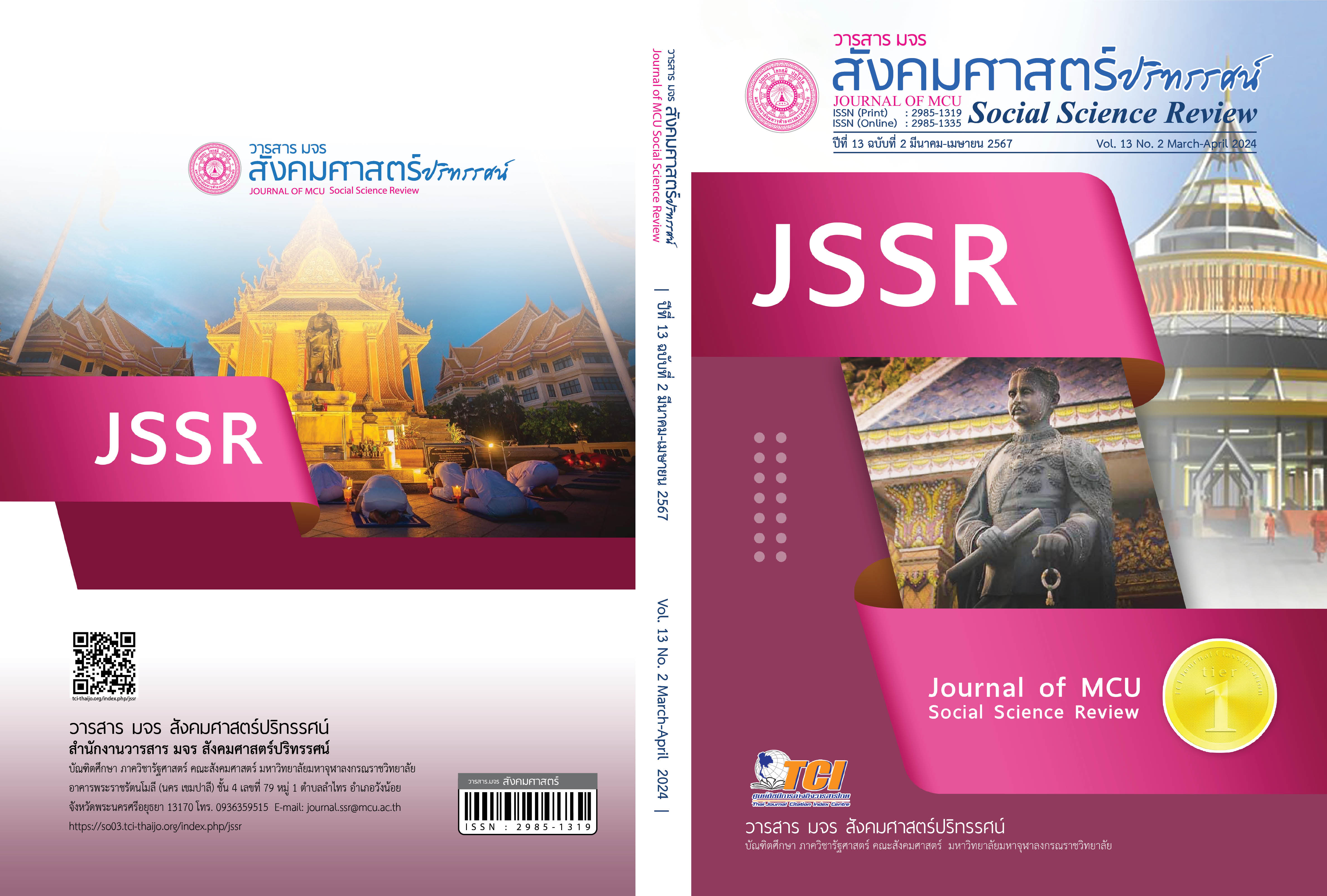แนวทางการนำมหาสติปัฏฐานสูตรมาประยุกต์ใช้กับการแสดงในการเข้าถึงอารมณ์ของตัวละคร
คำสำคัญ:
นักแสดง, สภาวะภายในของตัวละคร, สติปัฏฐาน4บทคัดย่อ
นักแสดงต้องใช้ร่างกาย จิตใจ อารมณ์และความรู้สึกเป็นเครื่องมือในการทำงาน แม้จะมีเทคนิคการแสดงในระดับสากลอยู่หลายเทคนิค แต่นักแสดงต้องหาวิธีการใช้เทคนิคการแสดงที่เหมาะสมเพื่อเข้าถึง คงอยู่ และออกจากสภาวะอารมณ์และความรู้สึกของตัวละครเมื่อการแสดงสิ้นสุดลง เหตุเพราะบางตัวละครมีประสบการณ์ที่แตกต่างจากตัวนักแสดง เช่น เป็นตัวละครที่มีอารมณ์รุนแรง ก้าวร้าว หรือสภาวะจิตที่มีแนวโน้มจะเป็นโรคทางจิตเวช เป็นต้น นักแสดงจึงจำเป็นที่จะต้องหาวิธีการเข้าถึง คงอยู่ และออกจากสภาวะอารมณ์และความรู้สึกของตัวละคร อย่างปลอดภัยต่อสุขภาพร่างกายและจิตใจของตนเอง บทความนี้จึงนำเสนอแนวคิด วิธีการประยุกต์หลักสติปัฏฐาน 4 ซึ่งเป็นแก่นหลักของพุทธศาสนา เพื่อใช้เป็นเทคนิคในการเข้าถึง คงอยู่ และออกจากสภาวะอารมณ์และความรู้สึกของตัวละคร โดยมีขอบเขตระยะเวลาการฝึกปฏิบัติ 1 เดือน โดยฝึกการเจริญสติรับรู้อยู่ใน 4 ฐาน ได้แก่ กาย เวทนา จิต และธรรม ผลการศึกษาพบว่า การฝึกเจริญสติตามแนวทางสติปัฏฐาน 4 เป็นพื้นฐานเพื่อเตรียมความพร้อมด้านร่างกาย จิตใจ ของนักแสดง ให้เข้าใจถึงความเป็นจริงว่าเราเป็นนักแสดงที่ได้รับรู้ และเข้าใจในความรู้สึกของตัวละคร โดยมีสติคอยกำหนดขณะแสดง และเมื่อจบการแสดงก็มีสติรับรู้และออกจากสภาวะตัวละครได้
เอกสารอ้างอิง
ณัฐพงศ์ รัตนเมธานนท์. (2562). การศึกษากลวิธีแก้ปัญหาการหมกมุ่นอยู่กับตัวเองขณะแสดงผ่านการฝึกฝนตามหลักการแสดงของ แซนฟอร์ด ไมส์เนอร์ : กรณีศึกษา ตัวละครลีโอ จากบทละครเรื่อง สีพันไมล์. กรุงเทพฯ: จุฬาลงกรณ์มหาวิทยาลัย.
ดังตฤณ. (2555). มหาสติปัฏฐานสูตร. กรุงเทพฯ: สำนักพิมพ์ฮาวฟาร์.
ตรีดาว อภัยวงศ์. (2551). การแสดง. ใน นพมาส แววหงส์, ปริทัศน์ศิลปะการละคร. (น. 87-104). กรุงเทพฯ: จุฬาลงกรณ์มหาวิทยาลัย.
นฤมล กระจ่างโฉม. (2563). ภาพลักษณ์และบทบาทของตัวละครเอกหญิงในนวนิยายของกฤษณา อโศกสิน ที่นำเสนอเป็นละครโทรทัศน์ในปี พ.ศ. 2560-2561 (วิทยานิพนธ์ศิลปศาสตรมหาบัณฑิต สาขาวิชาภาษาไทย). เชียงใหม่: มหาวิทยาลัยราชภัฏเชียงใหม่.
พระโสภณมหาเภระ (มหาสีสยาดอ). (2555). มหาสติปัฏฐานสูตร ทางสู่พระนิพพาน. กรุงเทพฯ: ห้างหุ้นส่วนจำกัด ประยูรสาส์นไทย การพิมพ์.
เพียงดาว จริยพันธุ์. (2561). การพัฒนาทักษะการแสดงนการแสดงเดี่ยวเรื่อง เดอะ ไซริงกา ทรี ตามหลักการแสดงของ ม.ล.พันธุ์เทวนพ เทวกุล. กรุงเทพฯ: จุฬาลงกรณ์มหาวิทยาลัย.
มณีบุษย์ษบัน ศิริอรรถ. (2565). การจัดกิจกรรมเสริมสร้างสติผู้ปฏิบัติธรรมสำหรับคฤหัสถ์ในสำนักปฏิบัติธรรมจังหวัดกาญจนบุรียุคฐานวิถีชีวิตใหม่ (วิทยานิพนธ์ครุศาสตรมหาบัณฑิต สาขาวิชาพุทธบริหารการศึกษา). พระนครศรีอยุธยา: มหาวิทยาลัยมหาจุฬาลงกรณราชวิทยาลัย.
ศูนย์ปฏิบัติธรรมโมลี. (2557). หลักสูตร และแนวทางปฏิบัติ. สืบค้น 8 กุมภาพันธ์ 2565, จาก https://shorturl.asia/EfJmV
สมเด็จพระญาณสังวร สมเด็จพระสังฆราชสกลมหาสังฆปริณายก. (2555). แนวปฏิบัติในสติปัฏฐาน. นครปฐม: โรงพิมพ์มหามกุฏราชวิทยาลัย.
สยาดอภัททันตวิโรจน. (2558). วิธีเจริญมหาสติปัฏฐาน. กรุงเทพฯ: สำนักพิมพ์ดีเอ็มจี.
ดาวน์โหลด
เผยแพร่แล้ว
รูปแบบการอ้างอิง
ฉบับ
ประเภทบทความ
สัญญาอนุญาต
ลิขสิทธิ์ (c) 2024 วารสาร มจร สังคมศาสตร์ปริทรรศน์

อนุญาตภายใต้เงื่อนไข Creative Commons Attribution-NonCommercial-NoDerivatives 4.0 International License.
เพื่อให้เป็นไปตามกฎหมายลิขสิทธิ์ ผู้นิพนธ์ทุกท่านต้องลงลายมือชื่อในแบบฟอร์มใบมอบลิขสิทธิ์บทความให้แก่วารสารฯ พร้อมกับบทความต้นฉบับที่ได้แก้ไขครั้งสุดท้าย นอกจากนี้ ผู้นิพนธ์ทุกท่านต้องยืนยันว่าบทความต้นฉบับที่ส่งมาตีพิมพ์นั้น ได้ส่งมาตีพิมพ์เฉพาะในวารสาร มจร สังคมศาสตร์ปริทรรศน์ เพียงแห่งเดียวเท่านั้น หากมีการใช้ภาพหรือตารางหรือเนื้อหาอื่นๆ ของผู้นิพนธ์อื่นที่ปรากฏในสิ่งตีพิมพ์อื่นมาแล้ว ผู้นิพนธ์ต้องขออนุญาตเจ้าของลิขสิทธิ์ก่อน พร้อมทั้งแสดงหนังสือที่ได้รับการยินยอมต่อบรรณาธิการ ก่อนที่บทความจะได้รับการตีพิมพ์ หากไม่เป็นไปตามข้อกำหนดเบื้องต้น ทางวารสารจะถอดบทความของท่านออกโดยไม่มีข้อยกเว้นใดๆ ทั้งสิ้น





